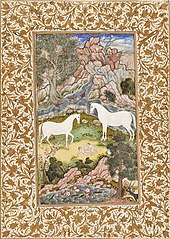Sanjna
| Sanjna | |
|---|---|
Goddess of Clouds and Twilight | |
Shraddhadeva Manu and Revanta |
Sanjna (
.Described as the daughter of the craftsman deity
.Etymology and epithets
Saraṇyū is the female form of the adjective saraṇyú, meaning "quick, fleet, nimble", used for rivers and wind in the
Textual sources and family

Sanjna is mentioned in the
The epic
Most scriptures mention 6 children of Surya by Saranyu:
- Yami — Lady of Yamuna[3][8]
- Ashvins — The divine twin physicians.[9]
- Revanta — Master of horses[9][3][8]
However, as per
Legends

According to many texts, the craftsman deity
Samjna is unsatisfied with her marital life. The Harivamsa states that power and heat of Surya has made him unpleasant looking to her, while according to the Markandeya Purana, Samjna's behaviour changes as she is unable to bear Surya's splendor or heat.
Meanwhile, Surya, unaware of the replacement, impregnates the look alike. Chhaya is partial to her own children. Yama later abuses and threatens her with his leg in the Harivamsa, while the Markandeya Purana tells that he kicks her. All texts mention that Chhaya casts a curse on him. In some versions, she curses Yama's leg to get infected with worms or fall apart or both. Surya gets to know that she was not Yama's mother due to the harsh punishment which a mother wouldn't consider. This behaviour of a mother to her child makes Surya suspicious and after confronting Chhaya, she discloses the whole incident.
Distressed, Surya goes to his father in law, and asks him to cure his splendor. Vishwakarma then reduces Surya's glory, making him pleasant to behold. Surya then locates Samjna, who was in the form of a mare, and after finding her, he assumes the form of a stallion and engages in love making with her. Samjna delivers twins Ashvins through her nose. Surya shows his normal form to her. Sanjana is pleased to see her husband's beauty and returns to her abode with her new-born twins.
In many Puranas, Vishvakarma uses Surya's heat to create many celestial weapons.[8]
Notes
Citations
- ^ a b c Kinsley 1986, p. 16.
- ^ Chisholm, Hugh, ed. (1911). . Encyclopædia Britannica. Vol. 9 (11th ed.). Cambridge University Press. p. 745.
- ^ ISBN 81-208-1491-6.
- ^ ISBN 978-0-89281-354-4.
- ISBN 978-0-226-15640-8.
- ISBN 978-0-89281-807-5.
- ^ Prabhupada. "Bhaktivedanta VedaBase: Śrīmad Bhāgavatam: Chapter 13: Description of Future Manus". The Bhaktivedanta Book Trust International, Inc. Archived from the originalon 15 February 2011. Retrieved 5 July 2010.
- ^ a b c d e Puranic Encyclopedia: a comprehensive dictionary with special reference to the epic and Puranic literature, Vettam Mani, Motilal Banarsidass, Delhi, 1975, p. Samjñā
- ^ ISBN 81-7488-168-9
- ^ Wendy 1984, p. 154.
- ^ Wendy 1988, p. 158 (for Harivamsa).
- Wilson, Horace Hayman (1866). "II". The Vishńu Puráńa: a system of Hindu mythology and tradition. Vol. 8. London: Trubner & Co. pp. 20–23.
References
- Kinsley, David R (1986). Hindu Goddesses: Vision of the Divine Feminine in the Hindu Religious Traditions. University of California Press. ISBN 81-208-0379-5.
External links
 Media related to Samjna at Wikimedia Commons
Media related to Samjna at Wikimedia Commons

